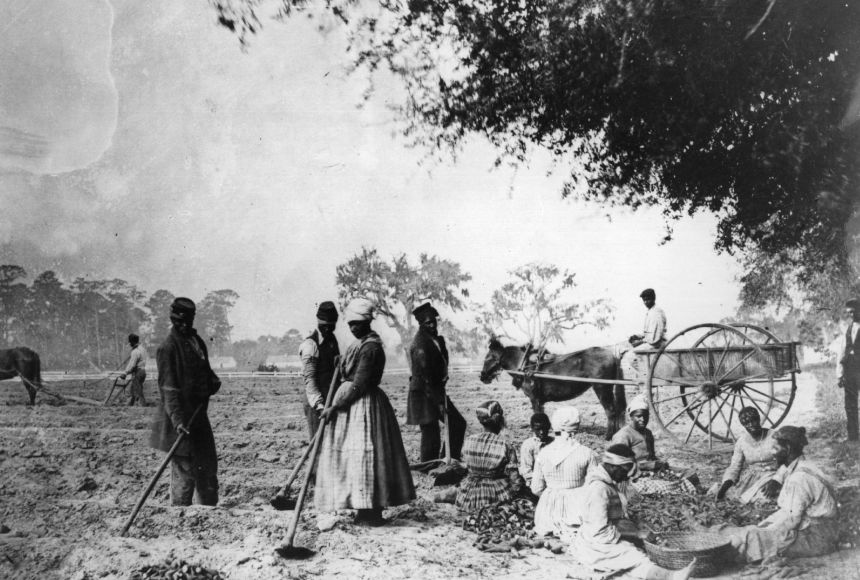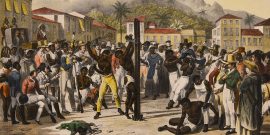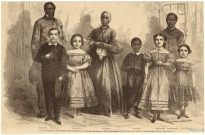To move forward on race relations, we first need to understand the inherent complexities about slavery and slaver-ownership.
A Historian Complicates the Racial Divide
Brandeis University historian David Hackett Fischer’s African Founders illuminates the leading controversies today with facts that shame political cant and enable us to reassess the centuries of slavery’s effects on American national character. In a scholarly tome of over 900 pages, Fischer follows the method of his earlier work, Albion’s Seed: Four British Folkways in America. There he traced the peopling of America from the perspective of the character of different regions of Britain.
African Founders achieves the equivalent with the enslaved peoples from Africa—who have hitherto largely been treated as a hapless, homogeneous heap of unfortunates, and blank slates completely recreated by masters and brutal overseers. Fischer does not hold back on detailing the brutality of slavery, but he also insists on keeping in mind the abiding character traits exhibited by the slaves from different regions of Africa. No rewrite of Roots, this scholarship forces corrections in perception created by the ideological uses of black American history then and now. Properly interpreted, this persuasive array of facts and historical exploration is an invaluable weapon against “Woke” nonsense. Perhaps that is why its reception has been for the most part less than enthusiastic. Fischer’s narratives convey an excitement that inspires awe and gratitude in the reader.
A revealing example of the fruits of his approach is his study of slavery in the Chesapeake Bay region, which comprises Maryland and eastern Virginia, with Baltimore to the north, Richmond, Jamestown, Williamsburg, and Norfolk to the south, and Alexandria toward the middle, on the Potomac. Fischer’s tightly organized account covers three regions (north, south, and frontier) each with three geographic sub-regions that describe in detail different traits ascribable to the way these chosen slaves and their descendants interacted with whites.
Fischer begins by asking why the Chesapeake Bay region of the early United States produced outstanding black leaders such as Frederick Douglass, Harriet Tubman, and Booker T. Washington—two Marylanders and a Virginian? In 1790, Virginia’s overall African population was 37 percent, with 35 percent in Maryland. (See Diana Schaub’s review for a thoughtful exposition of Douglass as an example of a Chesapeake slave.)
Although slaves came from various parts of Africa, Fischer estimates that during the slave trading era “about half of all arriving Africans in the Chesapeake came from what is now southeastern Nigeria” and were known variously as Igbos, Ibos, or Biafrans. They “came directly or indirectly from the West Central Africa regions of Congo, Loango, and Angola.” The regions became known for fostering slaves who worked hard and displayed discipline and intelligence.
Buying slaves of a particular ethnicity therefore became important for economic output and efficiency and for fostering marriages, so slavedealers would often seek Igbos. Later, such enterprising Igbos became known as the “Jews of Africa.” Imagine a scenario in which American slave merchants offered for sale Jews from, say, Lithuania. Such a concentration of enslaved Jews in an American region could have enormous effects on the character of those colonies. (Consider Genesis: 37-50 on Joseph’s rise from slave to Pharaoh’s prime minister.) Fischer makes similar claims about the mutual effects of slave and free men on each other in colonial and early American history.
In the Chesapeake region, the American aristocracy of founders provided models for not only the whites but also the blacks who arrived there, and the blacks’ demands for freedom made impressions on them. That desire for freedom displayed the universality of what became known as natural rights following the 1689 publication of John Locke’s Second Treatise of Civil Government. Keep in mind, too, that Fischer won the Pulitzer Prize in History for his portrayal of George Washington’s legacy in Washington’s Crossing. In Tocquevillian terms, Fischer writes about both democratic and aristocratic history—on broad themes such as migration and high themes such as the character of statesmen.
In other words, Fischer provides an alternative to simplistic accounts characterizing slaves who were merely the products of their new environment, whether brutalized victims or newly skilled workers. None of this makes slavery more just or acceptable. But it does help us understand early attitudes toward slaves and the impressions they made on their masters, besides the profitability of their labor.
African slavery produced a more complicated legacy than is generally acknowledged.
An illuminating contrast with the Chesapeake is found in the South Carolina planters who, seeing the freedom-loving ways of blacks up North, declined to purchase Igbo slaves. In the period from 1716-1807, about half of South Carolina slaves came from Africa’s west and windward coasts, with another 21 percent unspecified. These “Coromantees” were intelligent and loyal, when treated properly; they were “docile,” in the eighteenth-century sense. The blacks also outnumbered the whites by 3-1. The whites knew about the New York slave revolt of 1712, led by Asantes, a warrior people, from the region of modern Ghana. These masters had also experienced the September 1739 Stono Rebellion southwest of Charleston. “These free-spirited African people were thought to prefer death to slavery, and were reputed to be frequently suicidal.” (America’s fear of suicide warriors began early.) Slaveholders did not need the Haitian revolts of the 1790s to make them question the worth of their dangerous human property, though the Haitian atrocities certainly focused their minds.
Fugitive slaves (about half Asantis from Angola and the Congo) fled South Carolina to swell the ranks of the African Seminoles in Florida, an area fought for by the British and the Spanish against the Americans. The history of this new ethnic group discloses 12 generations of warriors, from the early 1700s to the present, beginning with African warriors brought by Spaniards. The Black Seminoles joined the other Seminoles to fight Andrew Jackson. They were subsequently forced west to what is now Oklahoma and from there to Texas and Mexico. This spirited community fought the Texans, the French, and the Comanches. Their African herding experience translated into success with cattle in the New World. Their descendants reside today in communities in Texas, the Bahamas, and the Caribbean.
Perhaps the finest example of the taste for aristocracy among the slaves comes from Robert Sutcliff, a British Quaker who traveled in America in the early 1800s, likely describing the aftermath of what became known as Gabriel’s rebellion in Virginia:
In the afternoon I passed by a field in which several poor slaves had lately been executed on the charge of having an intention to rise against their masters. A lawyer who was present at their trials in Richmond, informed that on one of them being asked, what he had to say to the court in his defence, he replied, in a manly tone of voice: “I have nothing more to offer than what General Washington would have had to offer, had he been taken by the British and put to trial by them. I have adventured my life in endeavouring to obtain the liberty of my countrymen, and am a willing sacrifice in their cause: and I beg, as a favour, that I may be immediately led to execution. I know that you have pre-determined to shed my blood, why then all this mockery of a trial?”
This astonishing speech brings to mind why Uncle Tom’s Cabin describes early on a painting of George Washington in the slave’s humble house.
Building on Virginia’s (and Maryland’s) “regional tradition” of leadership beginning with Washington, Madison, and Jefferson, Fischer adds that “Chesapeake slaves who later became national leaders also reinvented American leadership itself, in fundamental and highly specific ways. In their hands, leadership in the United States became more expansive in its spirit, more intensive in its methods, more broad in its goals, and more human in its results.” One needn’t agree with all of Fischer’s assessments to appreciate the effects of his work.
We should also keep in mind that these first generations of slaves, despite legal inferiority, often experienced less racial segregation than we might suppose, with class similarities lowering barriers for intermarriage, in northern regions. Racial segregation was “not much in evidence. … Men and women of both races drank, smoked, caroused, fought, and slept together.” (See accounts of the New York City slave conspiracy and revolt of 1741.) In fact, “most [free black] families came from ‘white servant women who had children by slaves or free African Americans.’” Might some of these Irish indentured servant girls be descended from shipwrecked Spaniards from the Armada? African slavery produced a more complicated legacy than is generally acknowledged. The slaves even included some Muslim scholars among their number. Also caught up were politicians, entrepreneurs, navigators, and linguists, as well as warriors. Even the tyrannical actions against the slaves could not obliterate these achievements, which were often prized and taken advantage of by their masters.
These slaves insisted on their freedom, fashioning the earliest slave revolts that often reflected their African warrior ancestry as an expression of the natural right of liberty. They were revolutionaries for freedom before its culmination in the Declaration of Independence. If there is an objectionable element in Fischer’s work, it is the misguided encouragement of a backward-looking approach to who we are as Americans. The answer to who we are as Americans is fully articulated in the Declaration, whose lights shine dimmer today than they have at any time in American history. Fischer’s history, replete with portraits of various African founders, is thus a resource not only for contemporary black Americans but for all Americans who would approach the Declaration rather differently knowing what the founding generation knew.
It remains one of the great paradoxes that the Declaration of Independence insisted on the equality of all men and also condemned the King’s incitement of slave revolts. Yet it took a great war to legally abolish slavery and square the circle of the Declaration. The Emancipation Proclamation was careful to authorize slave revolts only within hostile territory. The purgation of slavery required war, yet one conducted for the promise of “safety and happiness” within the boundaries of self-government.



